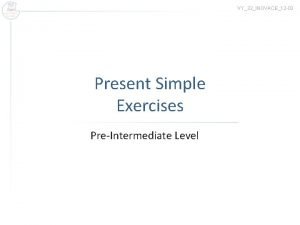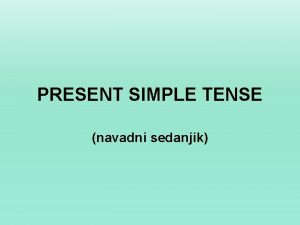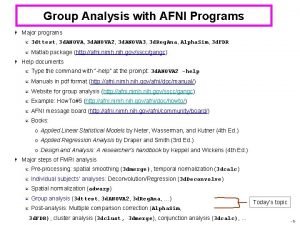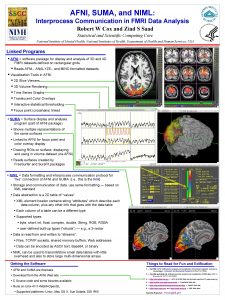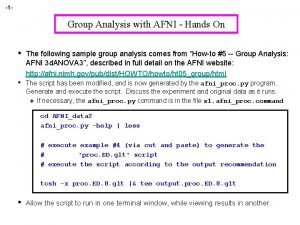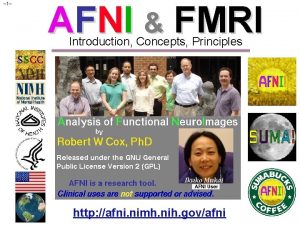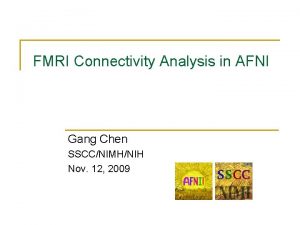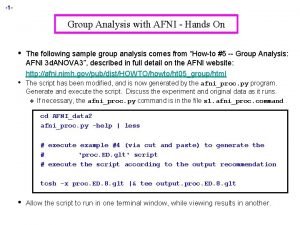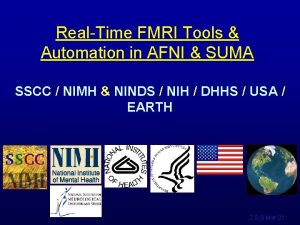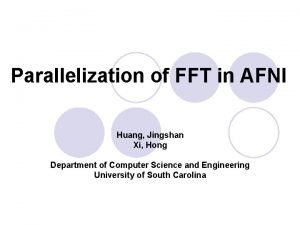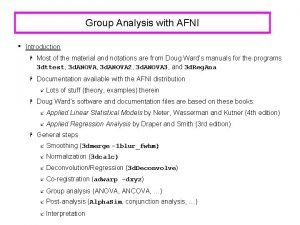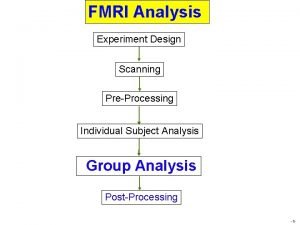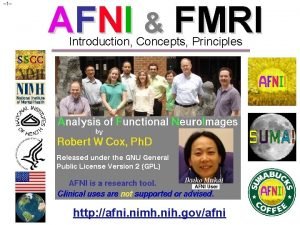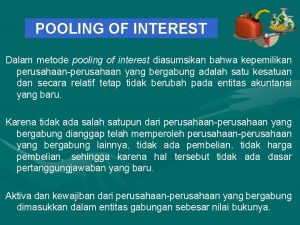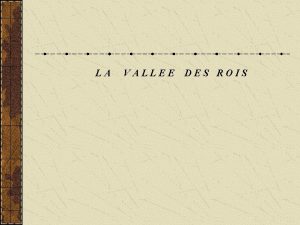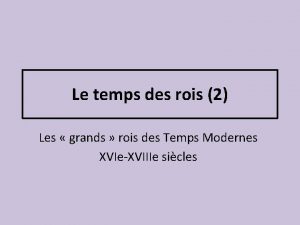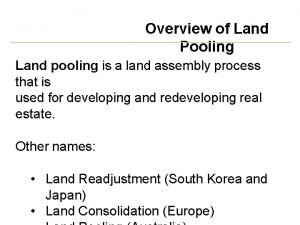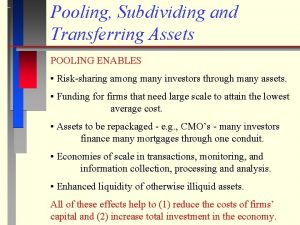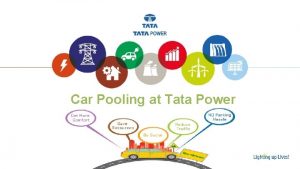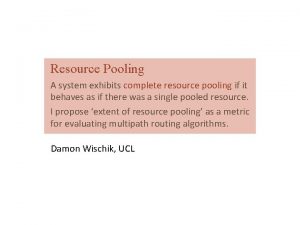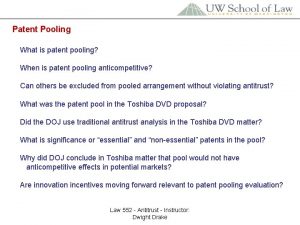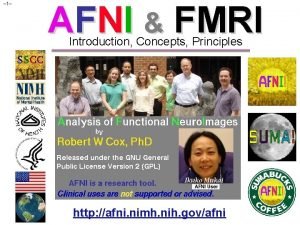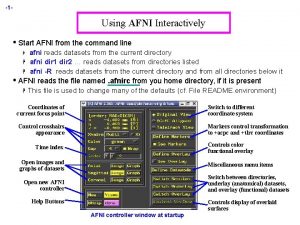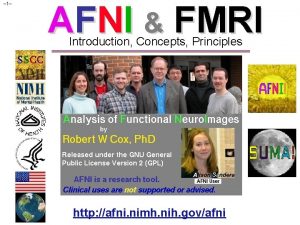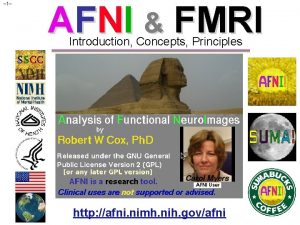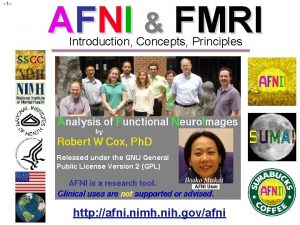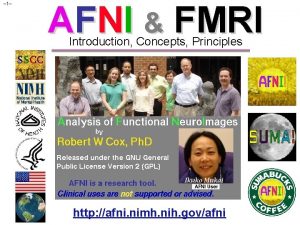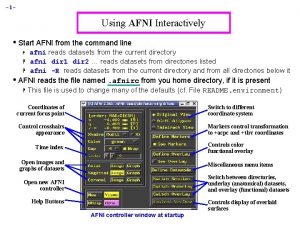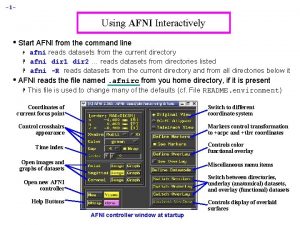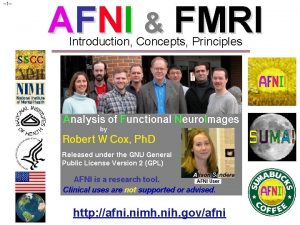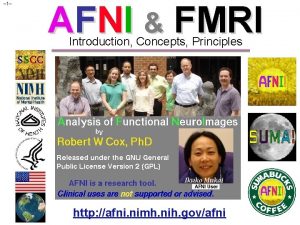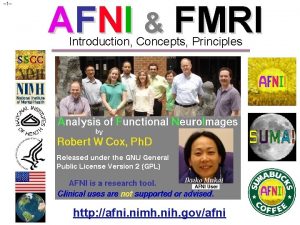Got ROIs Efficient Modeling through Information Pooling afni













![Bayesian Multilevel (BML) Modeling [blown up] Blue Line: effect of ZERO Bayesian Multilevel (BML) Modeling [blown up] Blue Line: effect of ZERO](https://slidetodoc.com/presentation_image_h2/ed0c4396208e8d2d90e9cc052e1a7feb/image-14.jpg)














- Slides: 28

Got ROIs? Efficient Modeling through Information Pooling afni 26_ROI-based-modeling. pdf Gang Chen Scientific and Statistical Computing Core National Institute of Mental Health National Institutes of Health, USA

Preview • Efficient modeling through information pooling o How to effectively avoid multiplicity penalty? • Demo dataset #1 o o Resting state: seed-based correlation analysis Handling multiple testing through ROI-based group analysis § o How to avoid penalty of modeling across voxels or ROIs? Program available in AFNI: Bayesian. Group. Ana. py • Demo dataset #2 o o Group analysis with correlation matrices among ROIs Handling multiple testing for inter-region data (IRD) analysis § o How to avoid penalty of modeling across voxels or ROIs? More applications § § DTI data: white matter connectivity network Naturalistic data analysis

Are you eating acrylamide for breakfast? Both sides good One side BURNT Both sides BURNT • Conditional probability • Knowledge updating

Conventional Statistical Framework: NHST • Two types of errors: null hypothesis significance testing (NHST) What is H 0 in FMRI studies? H 0 = no effect (activation, difference, …) at a voxel • Type I error = Prob(reject H 0 when H 0 is true) = false positive = p value Type II error = Prob(accept H 0 when H 1 is true) = false negative = b power = 1–b = probability of detecting true activation • Goal: control type I error rate while increasing power (decreasing type II errors) • Significance level α (magic number 0. 05) : p < α • Justice System: Trial Statistics: Hypothesis Test Hidden Truth Defendant Innocent Reject Presumption of Innocence (Guilty Verdict) Fail to Reject Presumption of Innocence (Not Guilty Verdict) Type I Error Hidden Truth Defendant Guilty Reject H 0 (defendant very unhappy) Correct (defendant very happy) Type II Error H 0 True H 0 False Type I Error Correct Not Activated (decide voxel is activated) Don’t Reject H 0 (decide voxel isn’t activated) (false positive) Correct Activated Type II Error (false negative)

Problems with NHST

Problems with NHST • Thresholding under NHST: dichotomized decision o p-value of 0. 05 vs 0. 051, or cluster size of 54 vs 53 voxels o Difference between “significant” & “insignificant” results o Selection bias about effect estimates in results reporting § Power analysis based on literature: not very useful § One source of reproducibility problem § Unreliable meta analyses (many effects get lost) • Cluster thresholding – “iceberg above water” approach o Using spatial extent as a leverage to control false positives o Cluster threshold of 54 voxels: cannot report 53 voxels? o Penalizing anatomically small regions: discrimination! § Unfair: 2 regions with same signal strength: 1 large and 1 small size § 2 regions with same signal strength: 1 case (distant) and 1 case (contiguous) o Sidedness for whole brain: one- or two-sided?

Appetizer #1: everybody loves GLM! •

GLMs: dealing with multiplicity! • Voxel-based group analysis: GLMs o o Penalty time for pretense: multiple testing (m = 100, 000), magic 0. 05 Show time for various correction methods § § § Voxel-wise p, FWE, FDR, spatial smoothness, clusters, … Simulations, random field theory, permutations, … How would dataset turn out under GLM? 4 lucky clusters manage to survive

Switching from voxels to ROIs: motivations • Motivations of ROI-based approach o o o Avoiding arbitrary thresholding and clustering No discrimination against small regions All regions judged by their strength, not physical size • ROI definitions o o Anatomical atlases Functional parcellations Previous studies Split current data § Part for localization and ROI definition, part for ROI-based analysis

Switching from voxels to ROIs: still GLMs • ROI-based group analysis : GLMs Focus: association between and seed-based correlation (z-score) o Pretense: ROIs unrelated o GLMs: mass univariate m = 100 ROIs → m = 100 models o Penalty time for pretense: multiple testing – what to do? o § § Bonferroni? Unbearable What else?

Switching from GLMs to LME • ROI-based group analysis : Linear Mixed-Effects modeling o o One model integrates all ROIs loosely constrained instead of being unrelated § § o Gaussian distribution: Is it far-fetched? Similar to cross-subject variability Goal: effect of interest b + βj o Fixed vs. random effects? o What can we get out of LME? § § o Estimates for fixed effects Variances for random effects Cul-de-sac! Overall effect: shared by all ROIs and subjects Effect by ith subject Unique effect by jth ROI

One more jump from LME to BML • ROI-based group analysis : Bayesian Multi-Level modeling o One model integrates all ROIs: same as LME, but under Bayesian o ROIs loosely constrained instead of being unrelated § § Gaussian distribution: is it far-fetched? Similar to cross-subject variability o Goal: effect of interest b + βj o Same model as LME plus priors § § o Markov chain Monte Carlo (MCMC) Inferences via posterior distribution Ka-ching! Effect by ith subject Overall effect: Unique effect shared by all ROIs by jth ROI

Inferences from BML: full distributions • ROI-based BML: 21 ROIs • Full report with richer information: posterior distributions for each ROI § No dichotomization § No results hiding § No discrimination against small regions • 8 ROIs with strong evidence of effect compared to § ROI-wise GLM with Bonferroni § Voxel-wise GLM at cluster level
![Bayesian Multilevel BML Modeling blown up Blue Line effect of ZERO Bayesian Multilevel (BML) Modeling [blown up] Blue Line: effect of ZERO](https://slidetodoc.com/presentation_image_h2/ed0c4396208e8d2d90e9cc052e1a7feb/image-14.jpg)
Bayesian Multilevel (BML) Modeling [blown up] Blue Line: effect of ZERO

Inferences from BML: quantile interval • ROI-based BML: 21 ROIs • full report with a table of quantile intervals • 8 ROIs with strong evidence for effect of interest

Inferences from BML: standard error • ROI-based BML: 21 ROIs • full report with bar graph quantile intervals (better visualization) o Nothing hidden under sea level • 8 ROIs with strong evidence for effect of interest

BML: model validations • ROI-based BML with 21 ROIs: cross-validation o Leave-one-out information criterion (LOOIC) Cross-validation o Posterior predictive checking • Effects of BML o Regularizing ROIs: don’t fully trust individual ROI data o Sacrificing fit at each ROI; achieving better overall fit GLM Data Realizations from fitted model BML

Appetizer #2: more love for GLM! • Dataset #2: correlation matrix o o Subjects: n = 41 children; response-conflict task Individual subjects: correlation matrix among m = 16 ROIs How to go about group analysis? § § GLM for each element in correlation matrix Binarization approach: graph theory § § Inter-region correlation (IRC) Structural attribute matrix (SAM) More broadly: matrix-based analysis (MBA) (“network modeling”) • Focus on GLM o Student t-test or GLM on each element § o o M = 120 mass univariate models Pretense again: all elements are unrelated Penalty time again: permutations?

Dealing with inter-region data (IRD) •

IRD: switching from GLM to LME • Overall effect: shared by all ROIs and subjects Effect by ith ROI Effect by jth ROI Effect by kth subject

IRD: one more jump - from LME to BML • Effect by Overall effect: ith ROI shared by all ROIs and subjects Effect by jth ROI Effect by kth subject

IRD – ROI effect from BML: full distributions • ROI-based BML: 16 ROIs • Full report with richer information: posterior distributions for each ROI § No dichotomization § Nothing hidden under sea level • 4 ROIs with strong evidence of effect compared to § Region effect inferences: unavailable from GLM and graph theory § Hubness?

IRD- ROI effect from BML: quantile interval • ROI-based BML: 16 ROIs • full report with quantile intervals • 4 ROIs with strong evidence for region effect

IRD – RP effect from BML: full distributions

IRD- RP effect from BML • ROI-based BML: 16 ROIs • full report for all region pairs (RPs) • Comparisons with GLMs: nothing hidden under sea level • 63 RPs identified by GLMs with p of 0. 05: none survived after correction with NBS via permutations • 33 RPs with strong evidence under BML GLM

BML: model validations • ROI-based BML with IRD of 16 ROIs: cross-validation o Leave-one-out information criterion (LOOIC) Cross-validation GLM o Posterior predictive checking • Effects of BML o Regularizing ROIs: don’t fully trust individual ROI data o Sacrificing fit at each ROI; achieving better overall fit BML

Summary • Efficient modeling through information pooling o How to effectively avoid multiplicity penalty? • Demo dataset #1 o o Resting state: seed-based correlation analysis Handling multiple testing through ROI-based group analysis § o How to avoid penalty of modeling across voxels or ROIs? Program available in AFNI: Bayesian. Group. Ana. py • Demo dataset #2 o o Group analysis with correlation matrices among ROIs Handling multiple testing for inter-region data (IRD) analysis § o How to avoid penalty of modeling across voxels or ROIs? More applications § § DTI data: white matter connectivity network Naturalistic data analysis (1: 20 PM, Sept. 25)

Acknowledgements • Paul-Christian Bu rkner (Department of Psychology, University of Mu nster) • Yaqiong Xiao, Elizabeth Redcay, Luiz Pessoa, Joshua Kinnison (Depart of Psychology, University of Maryland) • Zhihao Li (School of Psychology and Sociology, Shenzhen University, China) • Lijun Yin (Department of Psychology, Sun Yat-sen University, China) • Paul A. Taylor, Daniel R. Glen, Justin K. Rajendra, Richard C. Reynolds, Robert W. Cox (SSCC/NIMH, National Institutes of Health)
 Productively efficient vs allocatively efficient
Productively efficient vs allocatively efficient Productively efficient vs allocatively efficient
Productively efficient vs allocatively efficient Productively efficient vs allocatively efficient
Productively efficient vs allocatively efficient Allocative efficiency vs productive efficiency
Allocative efficiency vs productive efficiency Productively efficient vs allocatively efficient
Productively efficient vs allocatively efficient Bienvenue au culte d'adoration
Bienvenue au culte d'adoration Segunda reis 4 1 ao 7
Segunda reis 4 1 ao 7 Françoise engel
Françoise engel Residence des rois maures a grenade
Residence des rois maures a grenade Rois de france
Rois de france Present simple exercises intermediate
Present simple exercises intermediate Kdaj uporabljamo present simple
Kdaj uporabljamo present simple Family and friends 2 unit 1 lesson 5
Family and friends 2 unit 1 lesson 5 Modeling role modeling theory
Modeling role modeling theory Relational vs dimensional data modeling
Relational vs dimensional data modeling Afni group analysis
Afni group analysis Suma afni
Suma afni Afni group analysis
Afni group analysis Afni fmri
Afni fmri Erp afni
Erp afni Afni group analysis
Afni group analysis Afni dimon
Afni dimon Fft
Fft Does afni drug test
Does afni drug test Afni group analysis
Afni group analysis Afni fmri
Afni fmri Ttx railcar
Ttx railcar Pooling interest adalah
Pooling interest adalah Pooling vs unitization
Pooling vs unitization










